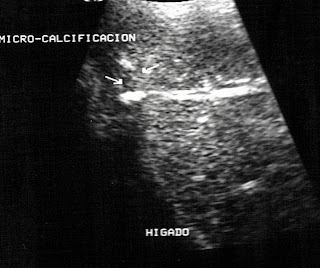Endometriosis Diagnosticada por Sonografia
Es bien sabido por todos lo difícil que es diagnosticar la endometriosis vía un examen eco-sonografico. Esto se debe a múltiples razones técnicas pero en ocasiones -usando técnica especial y prestando mucho tiempo y atención durante todo el examen- es posible detectar-en ciertas pacientes- los nódulos endometriosicos localizados en vejiga o intestinos, independientemente de los localizados en anexos u ovarios.Todo comienza con un interrogatorio para los datos clínicos específicos de esta patología tan sufrida por las pacientes que tienen la desgracia de padecerla ( menstruaciones marcadamente dolorosas, acompañadas de nauseas, vómitos y diarreas son datos claves para orientar clinicamente, junto a esto infertilidad primaria que agrega un sufrimiento mas para estas pacientes). Dado este primer paso, durante el examen sonografico vía transvaginal debemos prestar especial atención al área intestinal, cerca del fondo de saco posterior, en cortes axiales y sobre todo transversales, yendo con mucho cuidado en barridos lentos y sucesivos, tratando de hacer cortes milimétricos y desechando las imágenes cambiantes de las asas intestinales en movimiento y con material fecal que pueden crear confusiones con imágenes falseadas.Un colega, (A.S.) , ginecólogo, me sugirió hace algún tiempo, una técnica que vio realizar a una colega sonografista, dicha técnica consiste en llenar totalmente la vagina con gel ( 20-40 c.c. de gel ) para mejorar las imágenes, deseché la idea por engorrosa para el sonografista y sobre todo para la paciente , de hecho, no la he usado nunca. Lo que si he hecho es rellenar con mas gel el condón y ligando con una tira de goma la parte frontal del preservativo para mantener mayor cantidad de gel en la parte ¨activa´del transductor transvaginal, que es la única parte que sirve de ventana real durante el examen.Creo que puede ser una técnica útil en estos casos específicos.Otra idea que puede ser útil es el uso previo de un supositorio de gelatina para evacuar el tercio terminal del Colon y así facilitar el visionado de esa área.
En este caso se trata de femenina de 33 años de edad con historia desde su menarquia de dolores severos durante todas y cada una de sus menstruaciones, se acompaña de nauseas, vómitos y diarreas. Se queja de ser infértil y de que nunca le han diagnosticado y o tratado adecuadamente su condición. El examen sonografico transvaginal muestra un útero en anteversion con morfología y tamaño normal. Endometrio fino, 7,6 mm y fondo saco posterior normal. Ambos anexos y ovarios dentro de los parámetros normales.Dada la historia clínica de la paciente decidimos explorar con mas atención las asas intestinales y encontramos dos formaciones nodulares, hipoecogenicas,ovales de limites regulares y ecoDoppler negativas, miden aprox: 1,25 X 0.97 y 0.98 X 0.69 cm respectivamente.Concluimos que con la clínica de la paciente unido a los hallazgos ecosonograficos se trata de un caso de Endometriosis Intestinal que explica totalmente la situación.
Endometriosis Diagnosed by Sonography
It is well known by all how difficult it is to diagnose endometriosis via an echo-sonographic examination. This is due to multiple technical reasons, but occasionally -using a special technique and giving a lot of time and attention throughout the exam- it is possible to detect endometrial nodules located in the bladder or intestines, in some patients, independently of those located in annexes or ovaries. It all begins with interrogation for the specific clinical data of this pathology so suffered by the patients who have the misfortune to suffer it (menstruations markedly painful, accompanied by nausea, vomiting, and diarrhea are key data to orient clinically, along with this primary infertility that adds more suffering for these patients). Given this first step, during the transvaginal sonographic examination, we must pay special attention to the intestinal area, near the back of the posterior sac, in axial and, above all, transverse cuts, going very carefully in slow and successive sweeps, trying to make millimetric cuts and discarding the changing images of the intestinal loops in movement and with fecal material that can create confusions with false images. A colleague, (A.S), gynecologist, suggested to me some time ago, a technique that saw to realize to a sonographer colleague, said technique consists in completely filling the vagina with gel (20-40 cc gel) to improve the images, I dismissed the idea as cumbersome for the sonographer and especially for the patient, in fact, I have never used it. What I have done is to fill with more gel the condom and ligating with a strip of rubber the front of the condom to maintain more amount of gel in the active part of the transvaginal transducer, which is the only part that serves as a real window during the exam. I think it may be a useful technique in these specific cases. Another idea that may be useful is the previous use of a gelatin suppository to evacuate the terminal third of the colon and thus facilitate the viewing of that area.
In this case, it is a 33-year-old female with a history since her menarche of severe pain during each and every one of her menses, accompanied by nausea, vomiting, and diarrhea. She complains about being infertile and that she has never been diagnosed and treated properly. The transvaginal sonographic examination shows a uterus in anteversion with normal morphology and size. Fine endometrium, 7.6 mm, and normal sac or posterior fundus. Both attachments and ovaries within normal parameters. Given the patient's clinical history, we decided to explore the intestinal loops more closely and found two nodular, hypoechogenic, oval, regular, and negative echo-Doppler formations, measuring approximately 1.25 X 0.97 and 0.98 X 0.69 cm respectively. We conclude that with the clinic of the patient together with these findings it is a case of Endometriosis Intestinal that fully explains the situation.




